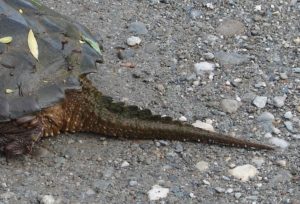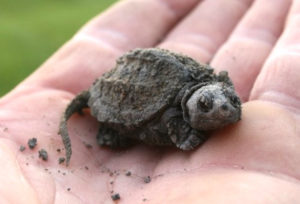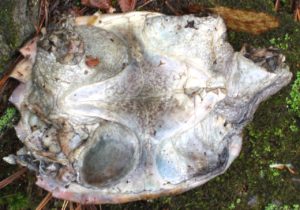Chelydra serpentina
Identification 
The Snapping Turtle is probably the most common turtle in Vermont. The carapace (shell covering the back) is shallowly domed with a strongly toothed posterior margin (see photo below). The plastron (shell covering the belly) is narrow, leaving the turtle’s flesh always partially exposed. It is uniformly grayish brown with no colorful markings, spots, or stripes. It is often covered in algae, giving it the nickname moss back.
The Snapping Turtle can get quite large. The upper shells of adults range from 10-18 inches long. The young have three keels that disappear with age and wear. They have a long tail that has spines along the top. They also have a long neck.
When out of the water Snapping Turtles are defensive. To prevent injury to yourself, you should stay out of reach of their long necks and strong jaws. When in the water, they try to avoid humans. Learn more about how we safely handle Snapping Turtles to move them across the road on our YouTube channel.
Get more detailed identification and life history information by downloading the chart here.
You can learn more about this species and see some video footage by checking out this short clip or this longer clip about nesting turtles from our Rattlers, Peepers & Snappers DVD. Find answers to some frequently asked questions about turtle nesting, what to do if a turtle nests on your property, and how to protect turtle nests at this link.
Range/Habitat

[ click image to zoom | download printable PDF ]
Snapping Turtles live in still or slow-moving bodies of water, particularly those with soft bottoms and emergent vegetation, such as cattails. The females leave the water in May and June to lay their eggs on land.
Status
This species has a state natural heritage rank of S5 (common). Please report sightings of this species in Vermont if you have not reported them within the last five years from a given location. Any natural history observations (feeding, migrations, road crossing areas, early or late season appearance, abnormalities, etc.) are appreciated. Photographs are always helpful, particularly if your report is the first report of this species from a town.
Additional Photos
More Info
- Chelydra serpentina at Animal Diversity website
- Chelydra serpentina at Canadian Herpetological Society website
Species summary written by Ariel K. McK. Burgess.
How to Help a Snapping Turtle Cross The Road
Lifting the turtle by the base of the hind legs works very well, but many people are wary of trying it. Snapping Turtles do have a dangerous bite and you should remember that their neck can reach just short of the length of their shells. Approach the turtle from behind and keep your hands low. Wrap your hands around the very base of the hind legs with the turtle facing up and away from you (see above photo and video below). They will resist at first with their very powerful legs and claws, but once your hands are in position, it is an easy and safe way to carry all but the very heaviest turtles.
If you are uncomfortable with this method of lifting a Snapping Turtle, other potential methods to move a turtle off the road can be seen in the video below.
Video from the Toronto Zoo YouTube channel.









